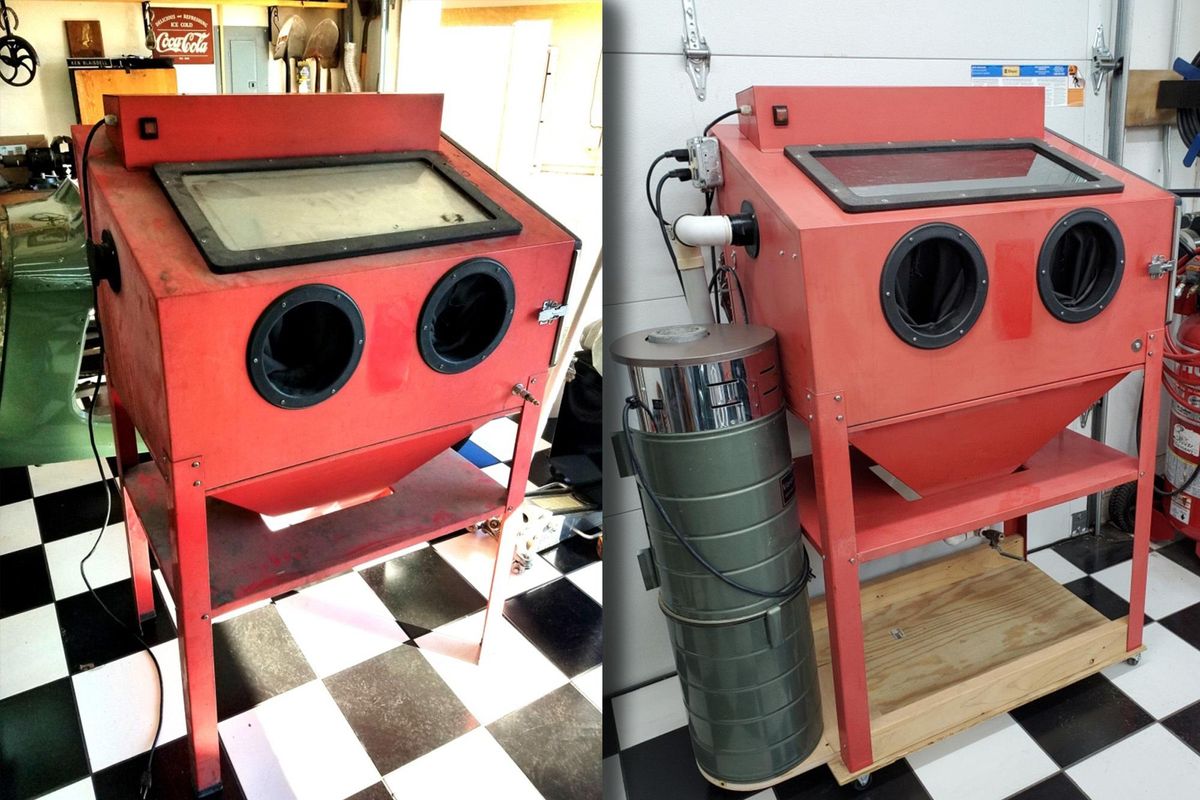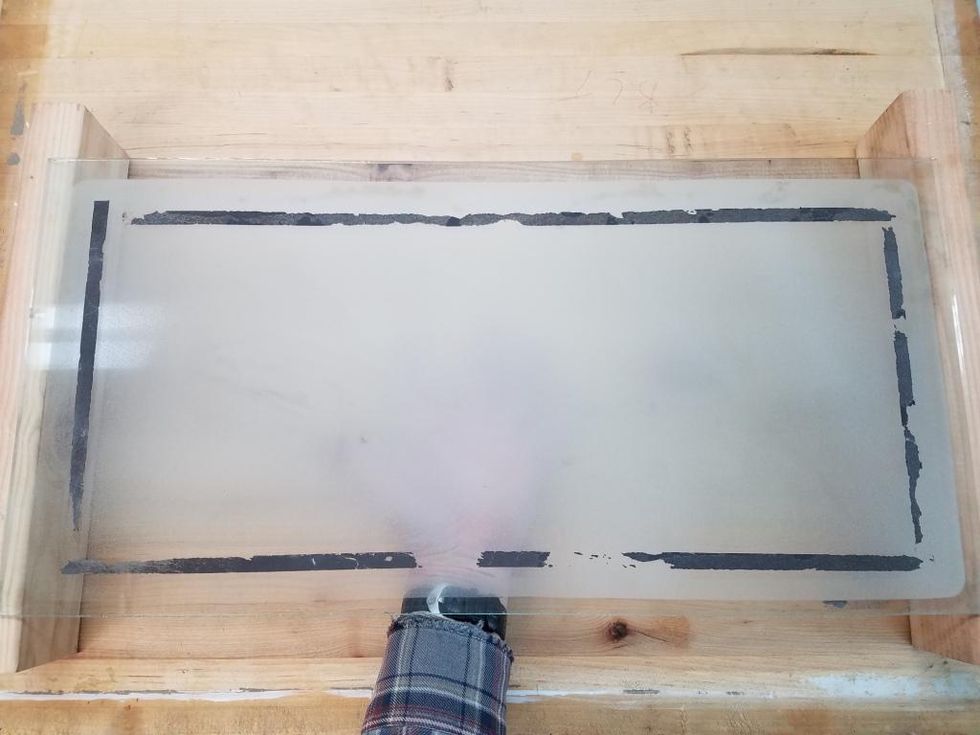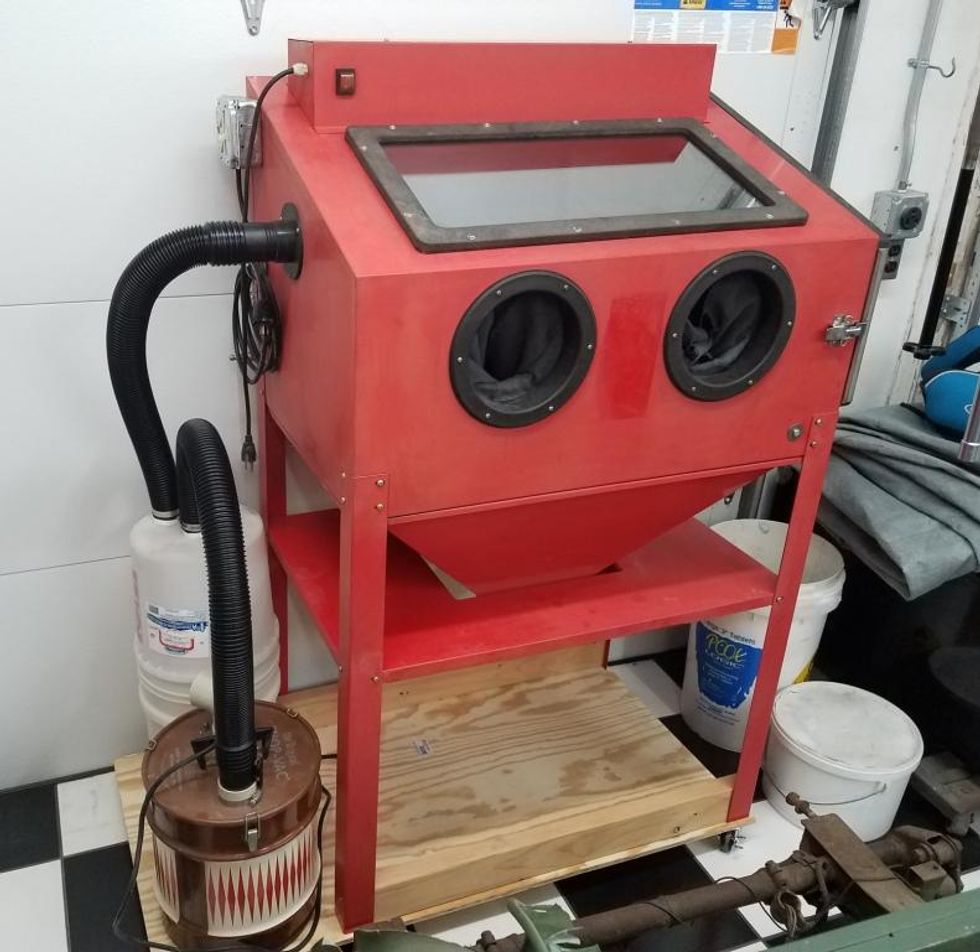How to get the most out of a $40 used sandblasting cabinet
A slight detour on the path to restoring a 1951 MG TD
10/10/2022

A slight detour on the path to restoring a 1951 MG TD

[Editor's Note: We'll have a full restoration profile on Ken Blaisdell's 1951 MG TD in an upcoming issue of Hemmings Classic Car, but sometimes restoring the car also means upgrading the tools we need to restore those cars. Such was the case when Ken realized he needed to level up his sandblasting cabinet, and we found his process worth sharing.]
This post isn't about the MG, per se, but about another of the tools I've needed to acquire to aid in its restoration. To go along with the sets of inch and metric tools that I already owned, I've had to get a set of "British Whitworth" size wrenches and sockets as well. I've also bought a number of Whitworth and odd-metric taps and dies to clean up Brutus-damaged threads.

One shop tool that is a virtual necessity for cleaning residual paint and rust off of old car parts is a sandblaster. I've had a little, yard-sale-find bench-top unit for a couple of years, and it has been very handy. However, the deeper I got into the MG, the larger the parts became, and I knew that I was outgrowing the little guy. Refinishing the four cylinder's valve cover was a stretch inside the small cabinet.
In one of those "listen to the voice" moments, it popped into my head to ask Kris, the owner of "The K.A.R Shop" in Gilbert, if he happened to know anyone getting rid of a sandblaster. He replied, "Yeah. I talked with a guy the other day who offered one to me, but I don't have room for it."
A few hours and $40 dollars later I was unloading it into my garage. Not surprisingly for the price, I had to restore the sandblaster itself before I could use it to help in the restoration of the car. As I am inclined to do, I upgraded it along the way.
First, of course, I cleaned it, then I found that both of the two-foot fluorescent bulbs were burnt out, so I replaced them with brighter LED versions. The viewing glass was completely opaque from being hit with the blasting sand, so that was replaced with new tempered glass. I modified the sand-siphon as several people suggested on YouTube, then I moved the air connection from the front to the side and added an air gun inside the cabinet to blow off the sand before taking the part out of the cabinet. I also fit the blasting gun with a larger-volume air hose.
I mounted the whole thing on a plywood platform that itself was mounted on casters. The platform is long enough that my DIY cyclone-style media collector and shop vac can stay on it to ride alongside the cabinet. I added an electrical box so that the light and vacuum can be powered from the same place with only one cord running to an outlet. The switch is so that I can turn the vacuum on and off easily without having to reach down and find its toggle switch.
Lastly, I made a set of "nut plates" for the window bezel. These are strips of 1/8-inch steel with tapped holes where the screws come through. There were a dozen separate nuts and lock washers on the screws from the factory. Needing to reach into the cabinet to hold all of those nuts and washers (and not drop them into the sand below) made removing the glass window for cleaning and maintenance something to be avoided. With the nut plates screwed to the cabinet, the window can now be removed from the outside without even opening the cabinet's door.
Photo by Ken Blaisdell
Opaque glass is a recurring problem with sandblasters and is usually overcome by taping a sheet of clear plastic to the inside that can be more economically changed out when necessary. Those sheets do have an associated cost and are hard to get in place while leaning into and contorting inside the cabinet. They also reduce the viewing area somewhat.












Now, back to the MG!
Hemmings.com, the premier online marketplace for classic cars, collector vehicles, and automotive enthusiasts, proudly announces a significant milestone: the sale of 2,500 vehicles through its innovative Make Offer platform. Achieving this remarkable feat in just over a year since its inception underscores Hemmings’ commitment to revolutionizing the buying and selling experience for collector car enthusiasts.
"Reaching 2,500 cars sold through the Make Offer platform is a significant milestone for Hemmings," stated Jonathan Shaw, Hemmings' president. "It underscores our commitment to delivering secure, efficient solutions that enhance the collector car experience, which fosters trust within our community and further solidifies the impact of our frictionless marketplace.”
The Hemmings Make Offer product was introduced just over a year ago, empowering buyers and sellers with a flexible and streamlined negotiation process. This unique tool allows buyers to submit offers directly to sellers, facilitating transparent and efficient transactions. With its user-friendly platform, Make Offer has swiftly become a preferred method for sealing deals within the Hemmings community.
"We couldn't be happier with how the Hemmings Make Offer platform has helped Black Horse Garage and introduced us to new clients. The business partnership between Black Horse Garage and Hemmings has given us a new avenue to introduce and offer our special automobiles to the vast customer base that Hemmings has had for so many years,” said Don Laviano, Communications Manager of Black Horse Garage as he expressed his satisfaction with the partnership with Hemmings. “Their platform has been easy to use for us and the car buying public. It is engaging, enjoyable, and successful. Black Horse Garage looks forward to being a part of their next 2,500 sales!”
The success of the Hemmings Make Offer feature is part of Hemmings' commitment to innovation and customer satisfaction. By leveraging cutting-edge technology and industry expertise, the feature continues to set new standards for excellence in the automotive marketplace.
Make Offer is built to take the hassle out of collector car buying and selling and is supported by the Hemmings.com suite of services, including Pay + Title, collector car valuation, shipping and an insurance marketplace.
Hemmings.com is the world’s largest collector car marketplace and includes a mobile app. Whether you're a novice or a seasoned collector, our seamless, integrated services offer an accessible entry point for all.
As Hemmings looks ahead to the future, its mission remains steadfast in connecting buyers and sellers, preserving automotive history, and fueling collectors' passions. With Make Offer as a strong element of the frictionless marketplace, the journey promises to be even more exhilarating and rewarding for all who share a love for classic cars and collector vehicles.
About Hemmings:
Founded in 1954, Hemmings is the world’s largest collector car marketplace. For nearly 70 years, our purpose has been to grow and uplift the collector car community because we’ve been part of it since the start of it. We help all willing drivers buy, sell, and beyond through a frictionless marketplace, quality entertainment and professional service. More information, services and content are available at Hemmings.com. Stay connected with Hemmings on Facebook, Instagram, and YouTube. Search tens of thousands of vehicle listings from the palm of your hand with the new Hemmings App.
Specialty Vehicle Engineering (SVE) has done it again with its latest power-adding limited-edition build, this time for the 2024 Chevrolet Corvette. The latest Yenko/SC sports car received some serious upgrades for the sizeable boost in performance that Yenko-badged vehicles are known for.
The Yenko 2024 Chevrolet Corvette is powered by a twin-turbocharged 6.2-liter LT2 V8 engine capable of 1,000 horsepower, around double the power of a stock Corvette. Depending on the 2024 Corvette’s trim level, the factory power ratings run between 490 to 670 horsepower.
Releasing 1,000 horses out of the stable was made possible by the addition of two 58-millimeter water-cooled turbochargers, but before the turbos were tacked on, the V8 engine received some upgrades of its own. An ARP high-strength head, a forged steel crankshaft, forged H-beam rods, forged aluminum pistons, and a proprietary camshaft strengthen the internals, while a custom intake manifold, CNC ported high-flow cylinder heads, an upgraded fuel system, and a custom tune further opens up the L2 to all the added power. SVE couldn’t stop there: The Corvette’s eight-speed dual-clutch gearbox was also upgraded to withstand the extra power and blast it to the rear wheels.
SVE tops off the upgraded powertrain with custom valve covers. In the rear, distinctive exhaust tips are added and are available in silver or black. Yenko-badged brake calipers can be had in select colors, with the standard option being red. Three different designs of staggered 19-inch front and 20-inch rear wheels are also available in various finishes. Inside of the new Yenko Corvette are embroidered logos on the headrests and floormats, characteristic of the company’s other Yenko offerings.
SVE is offering its Yenko Corvette in coupe or convertible body styles, with any of the currently available factory Corvette color choices. Nine colors are available for the SYC graphics, plus the addition of a tenth carbon fiber option.
SVE confirms it will build just 10 Yenko/SC Corvettes for the 2024 model year, but that production number will increase to 50 for 2025. The Yenko/SC Corvette package starts at $99,995, not including the initial cost of purchasing a new Corvette.
Are Yenko muscle cars more your style? Check out the latest supercharged 2024 Yenko/SC Chevrolet Camaro that makes more power than a supercar.